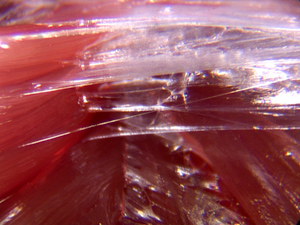Fascia, the Body’s Shape-Shifter
Our knowledge of fascia is beginning to expand rapidly. Until recently, it was viewed simply as extra tissue surrounding organs in the body. It was the “stuff” that surgeons cut through to reach the targeted organs. Now researchers are realizing there is more significance to the matrix of fascia that pervades our body.
What is Fascia?
Fascia exists throughout the body as a web of tissue made of collagen, elastin and a gel-like viscous inner substance. It appears to exist in at least three different layers: a superficial layer, a deeper layer beneath the fat cells, and an even deeper layer in the body, called epimysial fascia, that surrounds muscles and organs. However, all the layers are continuous and interconnected. The thin layers under the skin ultimately connect with the thicker layers surrounding muscles and bones. According to the Fascia Nomenclature Committee, “the [fascia] layers are bound to one another in a 3-D matrix that gives the body structure and helps it function in an integrated manner.”
Fascia surrounds every element of the body, the muscles, organs, bones, brain, and nerve cells. It is frequently referred to as our “organ of form.” It holds and supports the body against the pull of gravity. The most appropriate model of fascia to date is illustrated by 3-D tensegrity.
Tom Myers, from Anatomy Trains explains tensegrity:
A Communication System
Researchers now recognize that the fascia network is one of our richest sensory/communication organs. The surface area of this network is endowed with millions of endomysial sacs and other membranous pockets with a total surface area that by far surpasses that of the skin or any other body tissue.
Fascia is embedded with both the body’s vascular and nervous systems. Compared to these other systems, however, communication in the fascia network is faster: at 1,160 km / h vs. the nervous system, which is only 240 km / h .
We can see from the tensegrity model that if one node on the structure is touched, manipulated or stretched, the repercussions are felt throughout the structure almost immediately. Stress in the hip may be felt in the shoulder. Fascia allow the body to feel position and to change shape–hence, it can be thought of as allowing the body to shape-shift.
Fascia and Our “Inner Ocean”
The fascia also hold the cells and organs apart, forming a barrier to maintain a fluid extra-cellular matrix (ECM). This (ECM) is like the inner ocean of our bodies. All the cells in our body require space around them and this space is filled with an inert fluid that protects, cushions and holds the cells and tissues in place. The ECM has several substances that allow for cellular repair to take place, but its essential job is to facilitate the smooth action and functioning of the cells, muscles, and organs.
How to Maintain the Fascia
There is currently a lot of debate about how to maintain the fascia. It is unclear whether fascia needs to be “released” or, if this is even possible. Massage and stretching relax muscle tissue, but fascia is slow to respond to stretching.
What we do know, is that healthy fascia require two things:
First, adequate hydration to maintain the extra-cellular matrix, as well as the gelatinous core of the fascia tubules. Fascia can become crystallized and stiff without adequate moisture.
And second, daily regular movement through a wide range of motion without extensive stretching. The enemy of fascia health is extended sitting. Movement, like that in Tai Chi and Qi Gong, is likely to maintain the health and flexibility of fascia well into old age.

